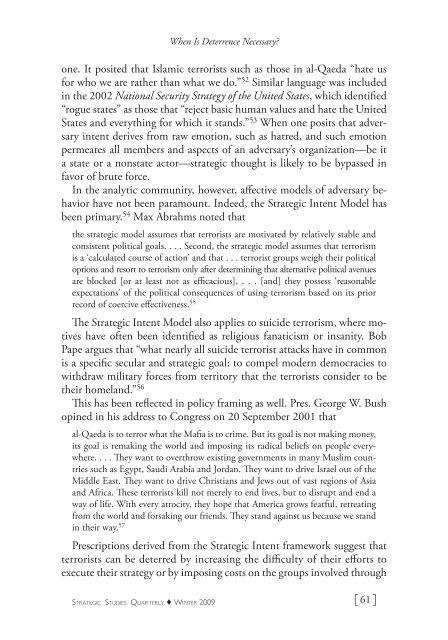When Is Deterrence Necessary? Gauging Adversary Intent
When Is Deterrence Necessary? Gauging Adversary Intent
When Is Deterrence Necessary? Gauging Adversary Intent
Create successful ePaper yourself
Turn your PDF publications into a flip-book with our unique Google optimized e-Paper software.
<strong>When</strong> <strong>Is</strong> <strong>Deterrence</strong> <strong>Necessary</strong>?<br />
one. It posited that <strong>Is</strong>lamic terrorists such as those in al-Qaeda “hate us<br />
for who we are rather than what we do.” 52 Similar language was included<br />
in the 2002 National Security Strategy of the United States, which identified<br />
“rogue states” as those that “reject basic human values and hate the United<br />
States and everything for which it stands.” 53 <strong>When</strong> one posits that adversary<br />
intent derives from raw emotion, such as hatred, and such emotion<br />
permeates all members and aspects of an adversary’s organization—be it<br />
a state or a nonstate actor—strategic thought is likely to be bypassed in<br />
favor of brute force.<br />
In the analytic community, however, affective models of adversary behavior<br />
have not been paramount. Indeed, the Strategic <strong>Intent</strong> Model has<br />
been primary. 54 Max Abrahms noted that<br />
the strategic model assumes that terrorists are motivated by relatively stable and<br />
consistent political goals. . . . Second, the strategic model assumes that terrorism<br />
is a ‘calculated course of action’ and that . . . terrorist groups weigh their political<br />
options and resort to terrorism only after determining that alternative political avenues<br />
are blocked [or at least not as effcacious], . . . [and] they possess ‘reasonable<br />
expectations’ of the political consequences of using terrorism based on its prior<br />
record of coercive effectiveness. 55<br />
The Strategic <strong>Intent</strong> Model also applies to suicide terrorism, where motives<br />
have often been identified as religious fanaticism or insanity. Bob<br />
Pape argues that “what nearly all suicide terrorist attacks have in common<br />
is a specific secular and strategic goal: to compel modern democracies to<br />
withdraw military forces from territory that the terrorists consider to be<br />
their homeland.” 56<br />
This has been reflected in policy framing as well. Pres. George W. Bush<br />
opined in his address to Congress on 20 September 2001 that<br />
al-Qaeda is to terror what the Mafia is to crime. But its goal is not making money,<br />
its goal is remaking the world and imposing its radical beliefs on people everywhere.<br />
. . . They want to overthrow existing governments in many Muslim countries<br />
such as Egypt, Saudi Arabia and Jordan. They want to drive <strong>Is</strong>rael out of the<br />
Middle East. They want to drive Christians and Jews out of vast regions of Asia<br />
and Africa. These terrorists kill not merely to end lives, but to disrupt and end a<br />
way of life. With every atrocity, they hope that America grows fearful, retreating<br />
from the world and forsaking our friends. They stand against us because we stand<br />
in their way. 57<br />
Prescriptions derived from the Strategic <strong>Intent</strong> framework suggest that<br />
terrorists can be deterred by increasing the diffculty of their efforts to<br />
execute their strategy or by imposing costs on the groups involved through<br />
Strategic Studies Quarterly ♦ Winter 2009 [ 61 ]
















